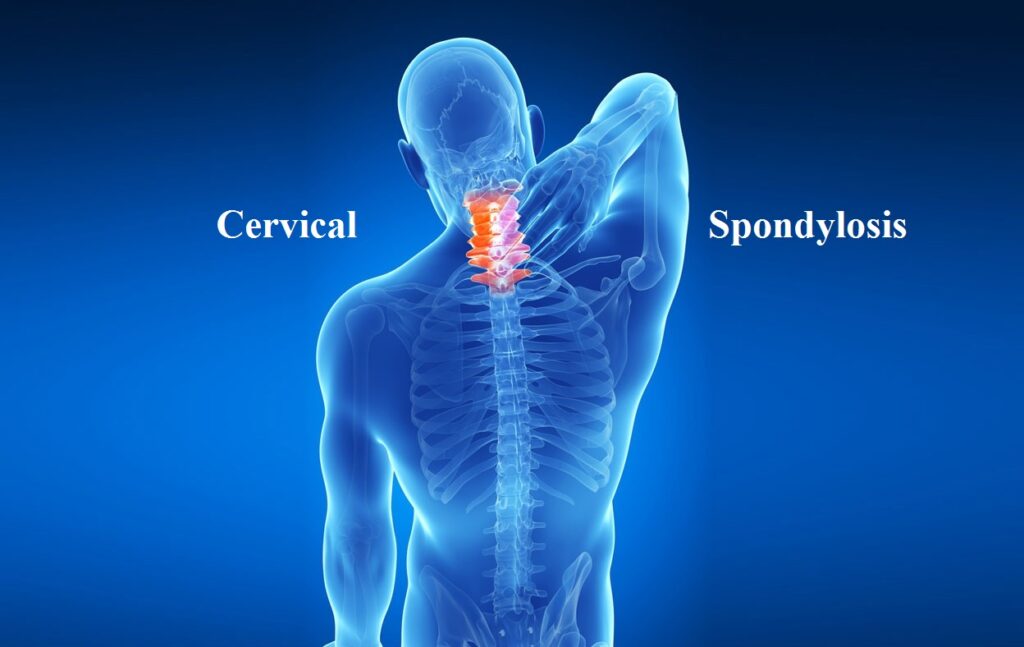Cervical spondylosis is a common degenerative disease that receives more acute with age. It is likewise called neck arthritis or cervical osteoarthritis.
Cervical spondylosis is found in extra than 85 percentage of people older than age 60. This condition may motive pain and stiffness withinside the neck for many people, however others with cervical spondylosis may never have any symptoms.
What causes cervical spondylosis?
Dehydrated spinal discs
The discs among spinal bones are typically thick and pad-like cushions. These disks help in absorbing the surprise of lifting, twisting, and different activities. Over the years, the gel-like material inner these discs dries out.This can lead to your bones rubbing together, making it painful.
Herniated discs
Spinal discs that act like cushions among the vertebrae of your spine can develop cracks, allowing leakage of the inner cushioning material. This material may want to press on the nerves and spinal cord and could result in arm numbness and pain radiating down the arm. Spinal disks begin drying out and shrinking as you age, allowing more bone-on-bone contact with vertebrae.
Stiff ligaments
With age, spinal ligaments can turn out to be stiff, making your neck lose its flexibility.
Bone Spurs
A bone spur is a bony lump developing off a bone. Bone spurs can expand over more extended periods. When the cartilage in joints of vertebrae for your spine begins to degenerate and the bone tissue tends to run against other bone tissue, a peculiar bone growth happens. The growth is alongside the edges of the vertebrae.These growths are, but common as you age.
What are the risk factors of Cervical spondylosis?
Aging is the greatest risk aspect for cervical spondylosis. The condition frequently develops as an outcome of changes that appear for your neck joints as you grow older. Dehydration, disc herniation, and bone spurs are all effects of aging.
But there are sure factors other than aging that may increase your risk of cervical spondylosis. These include the following
. Being inactive and overweight
. Injuries to the neck
. Holding your neck in an uncomfortable position for long durations of time
. Genetic factors
. Smoking
. Jobs that want repetitive neck actions and awkward positioning. Normal a part of growing older
When should you see a doctor?
You must are trying to find medical attention while you notice a surprising onset of weak spot or numbness or loss of bowel control or loss of bladder. You have to also visit a medical doctor if you have pain to your top limbs and excessive excruciating pain.
Overview of the treatment for Cervical Spondylosis
The treatment for cervical spondylosis is depending on the severity of your symptoms. The most important aim of the treatment is to offer relief to the pain, help keep your regular activities as much as possible. The proper treatment also can assist in stopping permanent injury to the spinal cord and nerves.
Medication like non-steroidal anti inflammatory drugs (NSAIDs) is used over the long term to deal with cervical spondylosis. Sometimes, medical doctors additionally provide anti-seizure medications that inhibit pain pathways to lessen the pain, when the nerve is broken severely. The mental pain and distress this is as a result of the condition may be handled by cognitive behavioral therapy or counseling, that’s aimed at helping understand the motive of the pain and the way to maintain the normal life with this condition.
If you would like to realize more about the treatment options available for cervical spondylosis, you may seek advice from Dr. Ganesh Mundhe , Dr. Ganesh mundhe is a spine specialist in pimpri chinchwad, well-known for his excellent results. He is considered among the best spine in pune. He is also among the best spine specialist in the city of pune. He is available at NRS hospital, pune which is among the best spine surgery hospital in pimpri chinchwad.

